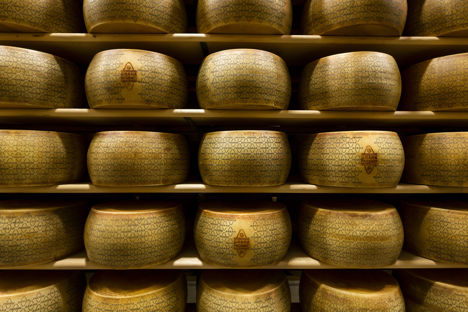
Grana Padano: Italy’s big cheese
In a country famed for having so many cheeses, it can be hard for one particular cheese to stand out. That’s why the producers of Grana Padano banded together in the 1950s to help it become one of the most beloved cheeses in Italy – and beyond. Get to know a bit more about this very special cheese and how it differs from Parmesan.
Grana Padano: Italy’s big cheese
In a country famed for having so many cheeses, it can be hard for one particular cheese to stand out. That’s why the producers of Grana Padano banded together in the 1950s to help it become one of the most beloved cheeses in Italy – and beyond. Get to know a bit more about this very special cheese and how it differs from Parmesan.
A plate of pasta with a simple tomato sauce is all well and good, but it’s only when you sprinkle some freshly grated cheese on top that it encapsulates everything good about Italian cuisine. Some of the nicest dishes you can have in Italy are often the simplest, and many of them will contain cheese. And while a lot of us might not think about the variety of cheese we’re grating over our dinner, many of the Italian ones have spent years maturing in giant halls. The recipes date back centuries, and Grana Padano – a hard cow’s milk cheese aged for at least nine months (but can be matured for over two years) – is nearly 1,000 years old.
The first records of Grana Padano go back to 1135, where it was made by monks at Chiaravalle Abbey in the Po Valley, in the north of Italy. Back then, making cheese was a way of using surplus milk, and the monks aged it over many months which resulted in its firm, grainy texture and unique flavour. The locals loved it, naming it formaggio di grana (‘grana’ means ‘grainy’), and soon enough it was being made and enjoyed across the whole of northern Italy.
This is how things were until right up to the 1950s – independent cheesemakers across northern Italy making their own versions of formaggio di grana for their local communities. But in 1951, dairy owners came together to form a consortium, agreeing certain rules about cheesemaking and the characteristics of certain styles. By 1955, formaggio di grana was known as Grana Padano (Padano referred to the Po Valley, also known as Valle Padana) and was made to strict guidelines set out by The Consortium for the Protection of Grana Padano Cheese (CTFGP). This body has been responsible for ensuring the consistency of this cheese ever since, and in 1996 successfully achieved PDO-protected status from the EU for Grana Padano.
How it's made
Since the 1950s, Grana Padano has been made in exactly the same way. 1,000 litres of semi-skimmed milk from cows reared in the Po Valley are used to make just two wheels of the cheese, which must be matured for at least nine months. At this point, the cheese is checked over by an expert who uses a special hammer to check the texture and a needle to pierce the wheel and ensure everything is up to scratch. If it passes the rigorous tests, then it is officially approved by the consortium – with a firebrand burning the Grana Padano logo into the rind. There are around 130 dairies dedicated to producing Grana Padano across five of Italy’s northern regions, with nearly five million wheels made every year.
After nine months of maturing and passing all the tests, a wheel of Grana Padano is ready for sale. A pale yellow colour with a light, milky flavour, it’s best used for shaving over salads or melting over hot dishes. However, some dairies leave the cheese even longer to achieve different flavours and textures. If it’s matured for over sixteen months, then the grainy consistency becomes more pronounced, crumbling when cut. Its sweetness begins to become overpowered by tangy, more savoury flavours, which work particularly well in soups, risottos and quiches. Finally, there’s the ‘Riserva’ – aged for at least twenty months with an incredibly rich, complex and full flavour. This is a truly special cheese which is best enjoyed as part of a cheeseboard, with either a soft red or sweet dessert wine.
How to cook with it
While it makes a fantastic addition to a cheeseboard, Grana Padano is also incredibly well-suited to cooking. It’s milky, creamy flavour comes to the fore when the cheese begins to melt, whether it’s simply grated over a bowl of pasta or used as an integral part of a recipe. When incorporated into a rich, creamy sauce, it can become the focal point of any dish, as Grana Padano’s nutty, deeply savoury flavour shines through. Even shaving the cheese over a simple salad can help bring something a little humdrum to life.
There are plenty of other ways to use Grana Padano in cooking. Rosana McPhee creates an aioli from scratch, grating the cheese in right at the end and serving it with white asparagus, while Valeria Necchio uses it to flavour her savoury biscotti. If you want to get a feel for how Grana Padano can be incorporated into recipes, try using it whenever you’d normally use cheddar or other cheeses.


